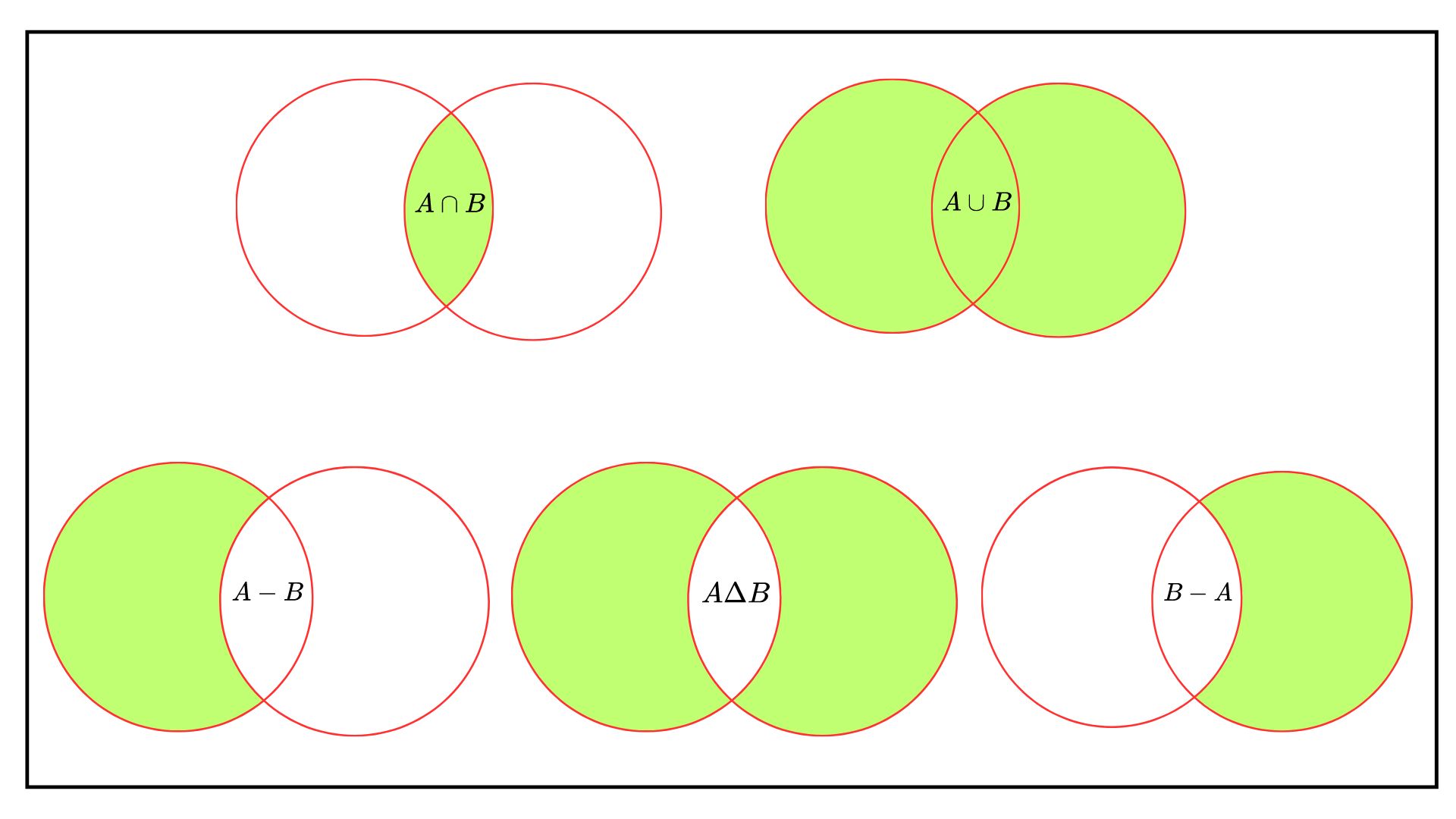In probability, an event is interpreted as a collection of possible outcomes of a random experiment.
Definition 1.1 ()
A random experiment is any repeatable procedure that results in one out of a well-defined set of possible outcomes.
- The set of possible outcomes is called sample space and denoted as .
- A set of zero or more outcomes is an event.
- A map that goes from events to probabilities is called a probability function and it is denoted as . Together, sample space, event space and probability function characterize a random experiment.
Set operations
There are several definitions related to sets and their operation.
Definition 1.2 ()
The complement of a set is denoted by and represents the set of elements that do not belong to , i.e.
Definition 1.3 ()
A set is said to be contained in a set if every element of is also an element of . Formally,
Definition 1.4 ()
Given two sets, is equal to , written , if and only if every element of is an element of and every element of is an element of . Formally,
Let’s now state some elementary operations between sets.
Definition 1.5 ()
The union of two sets, written , is the set of that belongs either to or , i.e.
As a consequence of the definition of the union the following relations holds true, i.e.
Definition 1.6 ()
The intersection of and is written and is the set of elements that belongs at the same time to and .
As a consequence of the definition of the intersection the following relations holds, i.e. Moreover, let’s state the distributive laws of the union and the intersection, i.e. And the De Morgan’s laws:
Definition 1.7 ()
The difference between two sets and , written (or also ), is the set of elements of that do not belong to . Formally
Given two set and , then each one can be written as the union of disjoint sets. In fact, their union can be decomposed into the union of three disjoint sets, i.e. and therefore for example the set can be written as
Definition 1.8 ()
The symmetric difference between two sets and is written and is the union of elements of that do not belong to and of elements of that do not belong to , i.e.
Proposition 1.1 Given two set , the symmetric difference can be written as
Proof. Let’s denote with , then apply the distributive law of the union twice (Equation 1.5) and develop the computations, i.e.
Indicator function
Definition 1.9 ()
An indicator function is a function that associate an to a real number, i.e. either 0 or 1. It is a tool that allows to transfer a computation from the set domain into the real numbers domain, i.e. . Formally, , i.e.
Proposition 1.2 The containment between two sets can be equivalently written in terms of indicator functions:
Proof. In order to prove the results in Proposition 1.2, let’s start by assuming and let’s distinguish two main cases.
- Assuming implies that , and therefore one have an equality .
- Assuming implies . In this situation for both cases one will have that , in fact:
- Considering implies that .
- Considering implies that .
Hence, assuming implies that for all . Now let’s assume the contrary: and let’s again distinguish in two main cases:
- Assuming , i.e. , the inequality holds and since the indicator function is bounded by 1 by definition it is possible to write . Therefore, one obtain and so .
- Assuming , i.e. , the inequality holds and it is possible to write . Hence, when , there are two possible cases, i.e.
- , but this implies that .
- , but this implies that .
When an implies that , but the contrary do not holds true. Hence, it is possible to conclude that .
Limits of sets
Let’s define the infimum () and the of a sequence of sets as: Informally, the infimum of a sequence of sets is the smallest set in , it follows that the limit of the infimum () is the biggest (union) among all the smallest (intersection) sets. Instead the supremum () and the are defined as: On the other hand, the supremum of a sequence of sets is the biggest set in , it follows that the limit of the supremum () is the smallest (intersection) among all the biggest (union) sets. Moreover, by De Morgan’s laws: and similarly
Fields and -fields
Definition 1.10 ()
Let’s consider the sample space , then a field is a non-empty class of subsets of closed under finite union, finite intersection and complementation. Formally, is a field if and only if:
- .
- .
- .
Definition 1.11 ()
Let’s consider the sample space , then a -field is a non-empty class of subsets of closed under countable union, countable intersection and complementation. Formally, is a -field if and only if:
- .
- .
- .
The main difference between a field and a -field is in the third property of the definitions. A field is closed under finite union, namely the union of a finite sequence of events indexed by (property 3 of Definition 1.10). On the other hand, a -field is closed under countable union, namely the union of an infinite sequence of events indexed by (property 3. of the Definition 1.11).

